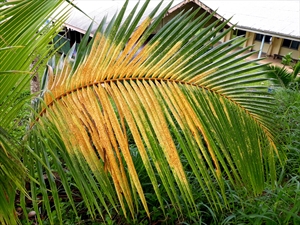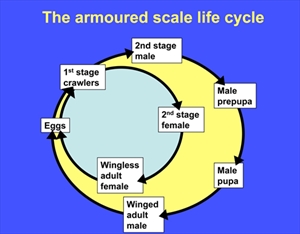Coconut scale, transparent scale
Pacific Pests, Pathogens and Weeds - Online edition
Pacific Pests, Pathogens & Weeds
Coconut scale (104)
Aspidiotus destructor
Asia, Africa, North, South and Central America, the Caribbean, Europe, Oceania. It is reported from Australia, American Samoa, Federated States of Micronesia, Fiji, French Polynesia, Guam, Marshall Islands, New Caledonia, Northern Mariana Islands, Palau, Papua New Guinea, Samoa, Solomon Islands, Tuvalu, Vanuatu, Wallis & Futuna.
Main hosts are coconuts and banana, but also avocado, breadfruit, cassava, guava, oil palm, sugarcane.
A potentially serious scale insect of coconut palms (Photo 1), but usually under biological control by coccinellid (ladybird) beetles.
Eggs are laid under the scale cover; they hatch and crawlers emerge, which, as the name suggests, have legs; they crawl over the host plant to find a place to feed. Within 12 hours they settle, form a scale cover and moult, losing legs and antennae. The scale is whitish, waxy, translucent, flexible and 1.5-2 mm across (Photo 2). Body parts of the circular females can be seen beneath the scale. The male scale is more oval and smaller. Males moult to form prepupae, and then moult again to form pupae. During these moults there are signs of wings and other appendages. The adult male has eyes, legs, antennae, and wings, but no mouthparts. After a day under the scale it emerges to fertilise nearby females.
However, fertilisation is not essential; unfertilised females give birth to males and females. The entire life cycle is about 30 days, and females lay about 90 eggs over a period of a week or so.
Apart from the ability of crawlers to walk, they can be spread widely by wind, flying insects, birds, machinery, and by human beings.
Mostly the scales occur in the underside of leaves, but in heavy infestations they colonise the upper surface, flowers and fruit. Infestations cause the fronds to yellow as the scales feed and inject toxic saliva. In extreme cases, leaves dry, fall and palms die.
Note that the scale is present in Fiji, Samoa and Solomon Islands, but it is not a pest in these countries. Tonga has a vulnerability to this scale.
Look for almost circular, whitish, waxy scales, so thin that the yellowish body of the insect can be seen beneath. Look for coconut leaflets that are covered with a yellow crust of scales when there are heavy infestations.
The management of coconut scale is entirely based on biological control, which has been very successful throughout the world, based on introductions of coccinellid beetles and wasp parasitoids.
QUARANTINE
The absence of the coconut scale from Tonga requires that quarantine authorities take precautions against its introduction. The FAO/IBPGR Technical Guidelines for the Safe Movement of Coconut Germplasm should be followed when imports of coconuts are made (see, (http://www.bioversityinternational.org/e-library/publications/detail/coconut/). But note that the scale has a wide host range, and precautions should be taken when importing plants of any kind.
NATURAL ENEMIES
Control of coconut scale outbreaks began in Fiji in the 1920s. Wasp parasitoids were collected from Java, and coccinellids from Trinidad. Of all those introduced, the ladybird beetle, Cryptognatha nodiceps (and later Cryptognatha gemellata) were the most useful in bringing the scale rapidly under control (see Fact Sheet no. 396). The beetles eat large quantities of coconut scales and have a preference for the insect. Another coccinellid, Rhyzobius satelles, was introduced in the 1970s. Good control has continued except where ants are present attending the scales for their honeydew.
The scale is rare in Solomon Islands, where a number of coccinellid predators are present: Chilocorus, Cryptolaemus montrouzieri (known as the mealybug ladybird - see Fact Sheet no. 395), Rhyzobius and Scymnus. Note, Pseudoscymnus anomalus, is said to be a specific coccinellid predator of coconut scale and is present in Micronesia. It had been effective against the coconut scale in Vanuatu.
In the Philippines, the wasp parasitoid, Aphytis lingnanensis controls the coconut scale. It is also attacked by Aphytis chrysomphali. The latter also attacks Aspidiotus rigidus (see Fact Sheet no. 348), but the rate of parasitism is low.
CULTURAL CONTROL
In the early stages of infestations, remove fronds colonised by the coconut scale.
RESISTANT VARIETIES
None known
CHEMICAL CONTROL
Insecticides may be useful on young palms, but not those that are mature because the crowns are too high to reach. There is also the likelihood that insecticides will destroy predators and parasitoids and delay bringing about natural and sustained control of the coconut scale.
- However, if necessary, use white oil (made from vegetable oils), soap solution, or horticultural oil (made from petroleum) (see Fact Sheet no. 56).
- White oil:
- 3 tablespoons (1/3 cup) cooking oil in 4 litres water.
- ½ teaspoon detergent soap.
- Shake well and use
- Soap:
- Use soap (pure soap, not detergent).
- 5 tablespoons of soap in 4 litres water, OR
- 2 tablespoons of dish washing liquid in 4 litres water.
- White oil:
- Commercial horticultural oil can also be used. White oil, soap and horticultural oil sprays work by blocking the breathing holes of insects causing suffocation and death. Spray the undersides of leaves; the oils must contact the insects. A second application of soap or oils may be necessary after 3-4 weeks.
- The addition of malathion is useful against scales insects, but it is likely to kill natural enemies. It is best avoided, if possible.
- Synthetic pyrethroid insecticides are likely to be effective against the crawlers - crawlers are the active nymphs that spread infestations to new plants and/or new gardens, but they are difficult to see as they are so small. And synthetic pyrethroids are likely to kill natural enemies. They are best avoided, if possible.
____________________
When using a pesticide, always wear protective clothing and follow the instructions on the product label, such as dosage, timing of application, and pre-harvest interval. Recommendations will vary with the crop and system of cultivation. Expert advice on the most appropriate pesticides to use should always be sought from local agricultural authorities.
AUTHOR Grahame Jackson
Information from Waterhouse DF, Norris KR (1987) Aspidiotus destructor (Signoret). Biological Control Pacific Prospects. Inkata Press; and from Watson GA, et al. (2016) Apidiotus rigidus Reyne (Hemiptera: Diaspididae): a devasting pest of coconuts in the Philippines. Agriculture and Forest Entomology 17:1-8 (https://www.researchgate.net/publication/264159039_Aspidiotus_rigidus_Reyne_Hemiptera_Diaspididae_A_devastating_pest_of_coconut_in_the_Philippines#:~:text=The%20coconut%20scale%20insect%2C%20Aspidiotus,Philippines%20between%202010%20and%202015). Photo 1 Mani Mua. Sigatok Research Station. SPC, Fiji. Photo 2 (and Diagram) Gillian Watson, Senior Insect Biosystematist, Plant Pest Diagnostics Branch, California Department of Food & Agriculture, Sacramento, CA, USA.
Produced with support from the Australian Centre for International Agricultural Research under project PC/2010/090: Strengthening integrated crop management research in the Pacific Islands in support of sustainable intensification of high-value crop production, implemented by the University of Queensland and the Secretariat of the Pacific Community.






